International Business Strategy
VerifiedAdded on 2023/06/03
|13
|3304
|410
AI Summary
This report proposes to prepare a case study on an organization that has global operations i.e. General Motors. The report includes case analysis, discussion and implications of topic for international business practices.
Contribute Materials
Your contribution can guide someone’s learning journey. Share your
documents today.
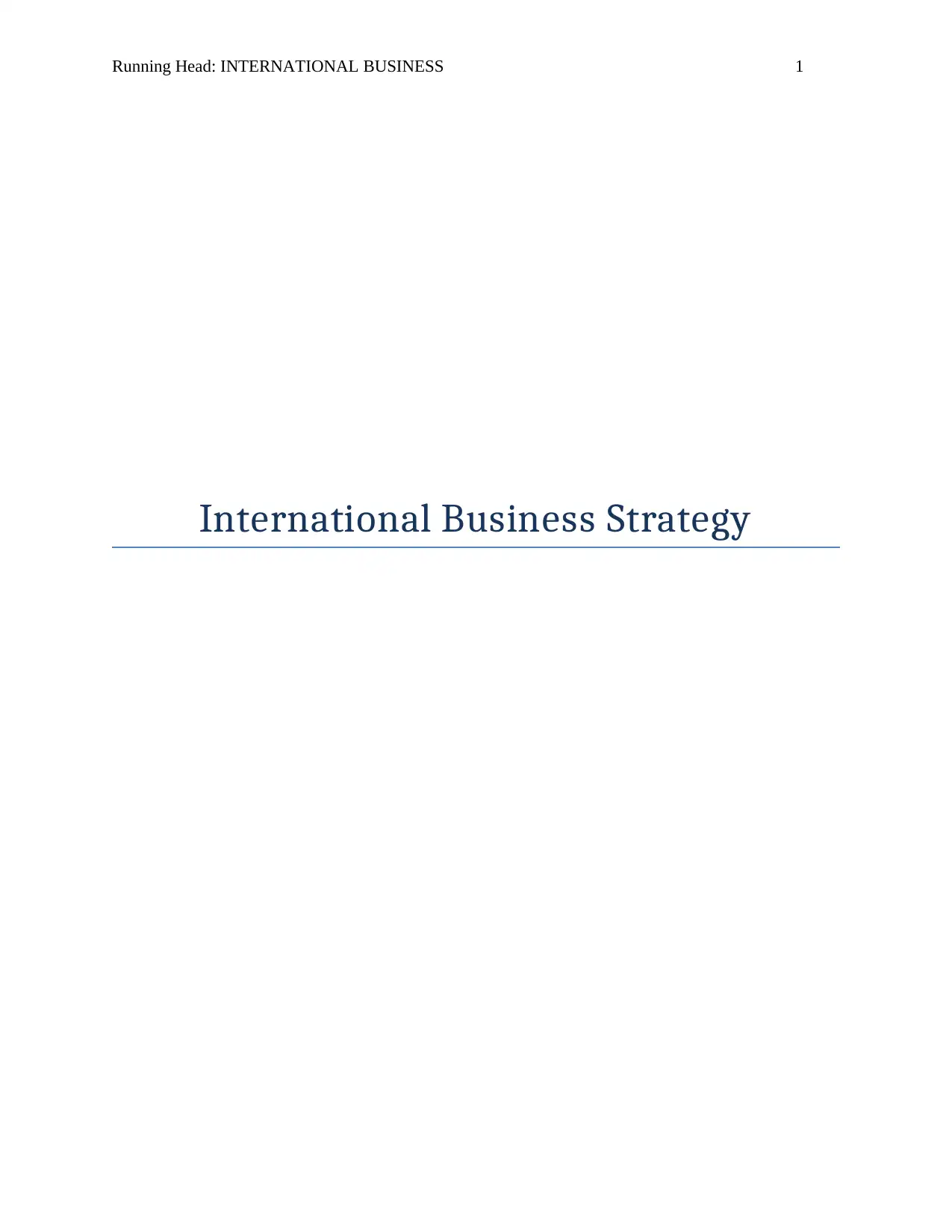
Running Head: INTERNATIONAL BUSINESS 1
International Business Strategy
International Business Strategy
Secure Best Marks with AI Grader
Need help grading? Try our AI Grader for instant feedback on your assignments.
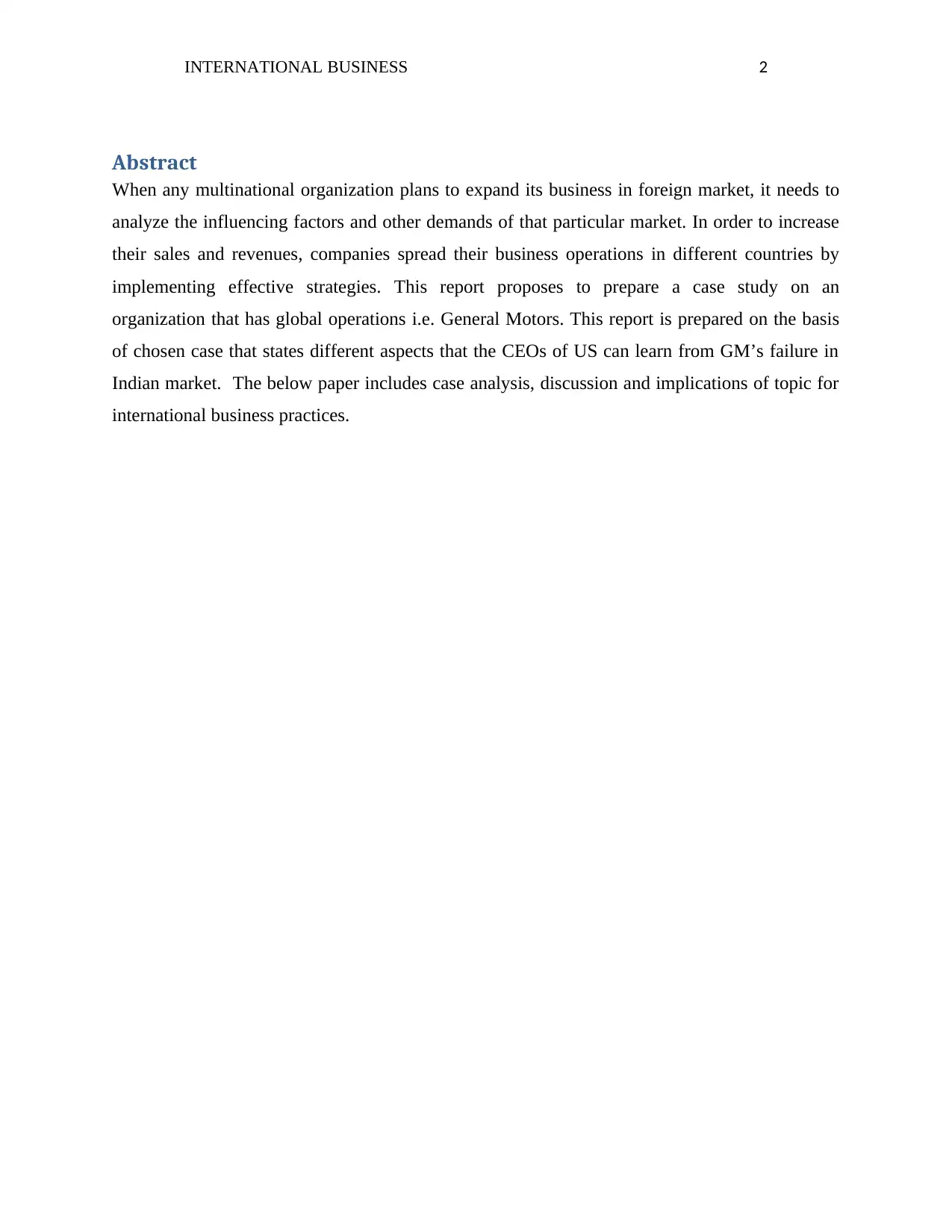
INTERNATIONAL BUSINESS 2
Abstract
When any multinational organization plans to expand its business in foreign market, it needs to
analyze the influencing factors and other demands of that particular market. In order to increase
their sales and revenues, companies spread their business operations in different countries by
implementing effective strategies. This report proposes to prepare a case study on an
organization that has global operations i.e. General Motors. This report is prepared on the basis
of chosen case that states different aspects that the CEOs of US can learn from GM’s failure in
Indian market. The below paper includes case analysis, discussion and implications of topic for
international business practices.
Abstract
When any multinational organization plans to expand its business in foreign market, it needs to
analyze the influencing factors and other demands of that particular market. In order to increase
their sales and revenues, companies spread their business operations in different countries by
implementing effective strategies. This report proposes to prepare a case study on an
organization that has global operations i.e. General Motors. This report is prepared on the basis
of chosen case that states different aspects that the CEOs of US can learn from GM’s failure in
Indian market. The below paper includes case analysis, discussion and implications of topic for
international business practices.
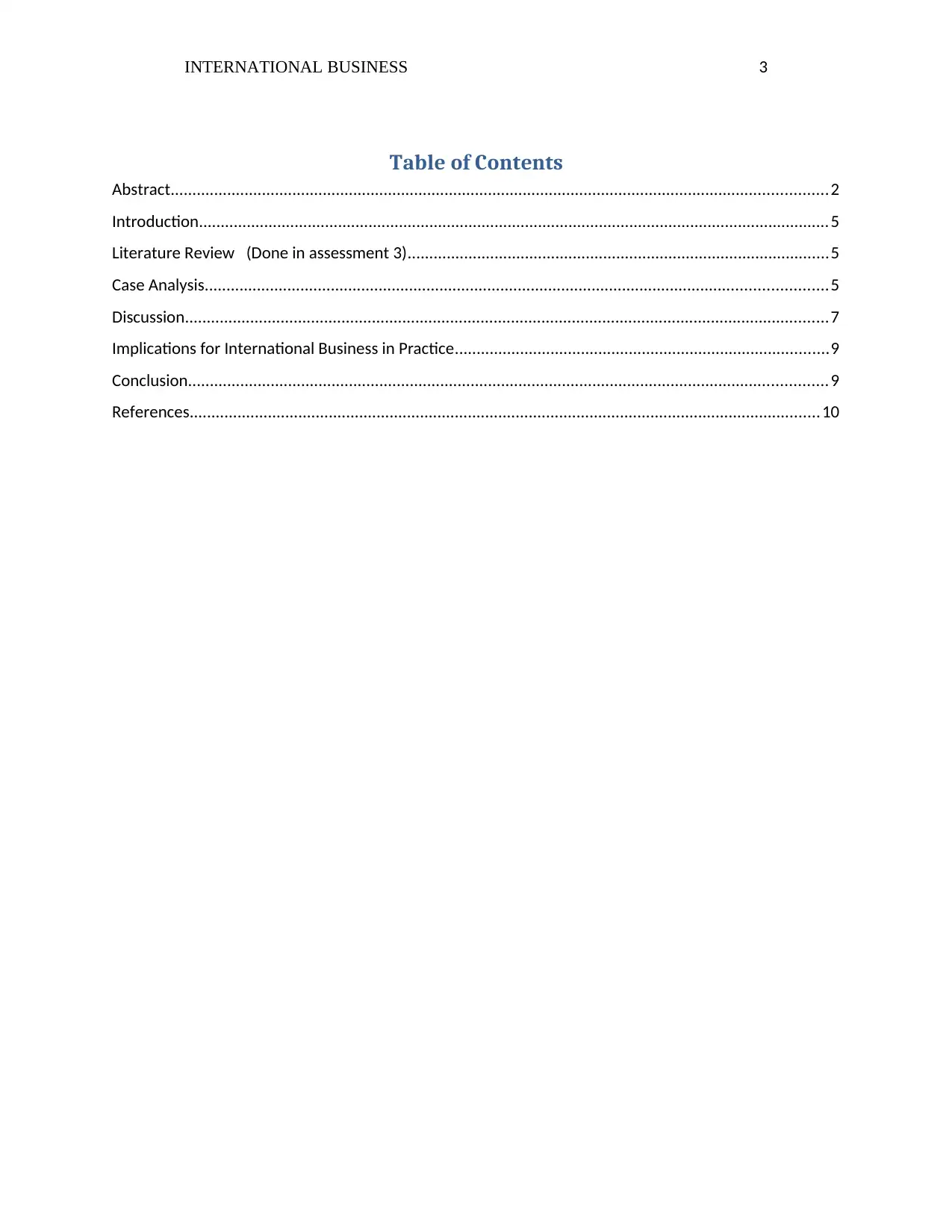
INTERNATIONAL BUSINESS 3
Table of Contents
Abstract.......................................................................................................................................................2
Introduction.................................................................................................................................................5
Literature Review (Done in assessment 3).................................................................................................5
Case Analysis...............................................................................................................................................5
Discussion....................................................................................................................................................7
Implications for International Business in Practice......................................................................................9
Conclusion...................................................................................................................................................9
References.................................................................................................................................................10
Table of Contents
Abstract.......................................................................................................................................................2
Introduction.................................................................................................................................................5
Literature Review (Done in assessment 3).................................................................................................5
Case Analysis...............................................................................................................................................5
Discussion....................................................................................................................................................7
Implications for International Business in Practice......................................................................................9
Conclusion...................................................................................................................................................9
References.................................................................................................................................................10
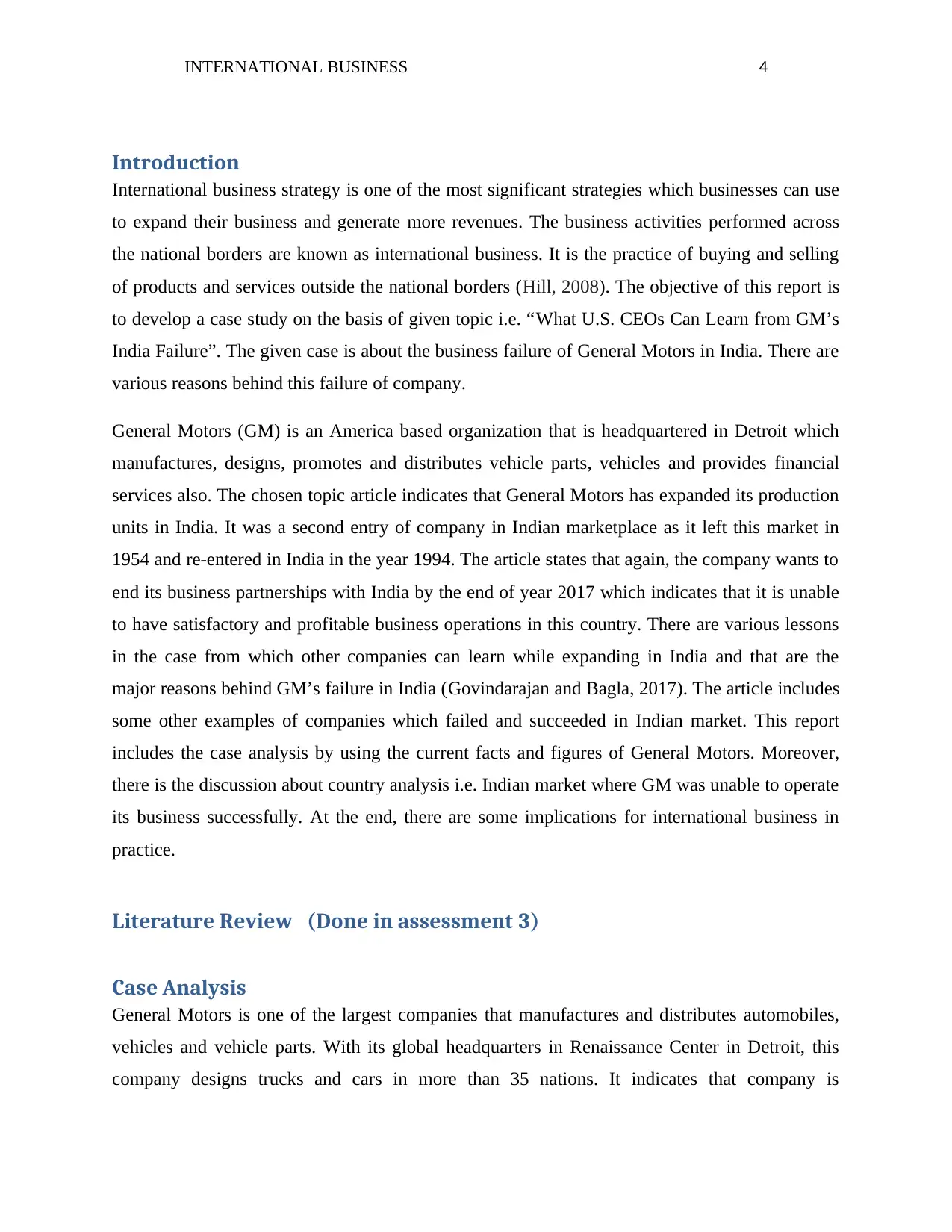
INTERNATIONAL BUSINESS 4
Introduction
International business strategy is one of the most significant strategies which businesses can use
to expand their business and generate more revenues. The business activities performed across
the national borders are known as international business. It is the practice of buying and selling
of products and services outside the national borders (Hill, 2008). The objective of this report is
to develop a case study on the basis of given topic i.e. “What U.S. CEOs Can Learn from GM’s
India Failure”. The given case is about the business failure of General Motors in India. There are
various reasons behind this failure of company.
General Motors (GM) is an America based organization that is headquartered in Detroit which
manufactures, designs, promotes and distributes vehicle parts, vehicles and provides financial
services also. The chosen topic article indicates that General Motors has expanded its production
units in India. It was a second entry of company in Indian marketplace as it left this market in
1954 and re-entered in India in the year 1994. The article states that again, the company wants to
end its business partnerships with India by the end of year 2017 which indicates that it is unable
to have satisfactory and profitable business operations in this country. There are various lessons
in the case from which other companies can learn while expanding in India and that are the
major reasons behind GM’s failure in India (Govindarajan and Bagla, 2017). The article includes
some other examples of companies which failed and succeeded in Indian market. This report
includes the case analysis by using the current facts and figures of General Motors. Moreover,
there is the discussion about country analysis i.e. Indian market where GM was unable to operate
its business successfully. At the end, there are some implications for international business in
practice.
Literature Review (Done in assessment 3)
Case Analysis
General Motors is one of the largest companies that manufactures and distributes automobiles,
vehicles and vehicle parts. With its global headquarters in Renaissance Center in Detroit, this
company designs trucks and cars in more than 35 nations. It indicates that company is
Introduction
International business strategy is one of the most significant strategies which businesses can use
to expand their business and generate more revenues. The business activities performed across
the national borders are known as international business. It is the practice of buying and selling
of products and services outside the national borders (Hill, 2008). The objective of this report is
to develop a case study on the basis of given topic i.e. “What U.S. CEOs Can Learn from GM’s
India Failure”. The given case is about the business failure of General Motors in India. There are
various reasons behind this failure of company.
General Motors (GM) is an America based organization that is headquartered in Detroit which
manufactures, designs, promotes and distributes vehicle parts, vehicles and provides financial
services also. The chosen topic article indicates that General Motors has expanded its production
units in India. It was a second entry of company in Indian marketplace as it left this market in
1954 and re-entered in India in the year 1994. The article states that again, the company wants to
end its business partnerships with India by the end of year 2017 which indicates that it is unable
to have satisfactory and profitable business operations in this country. There are various lessons
in the case from which other companies can learn while expanding in India and that are the
major reasons behind GM’s failure in India (Govindarajan and Bagla, 2017). The article includes
some other examples of companies which failed and succeeded in Indian market. This report
includes the case analysis by using the current facts and figures of General Motors. Moreover,
there is the discussion about country analysis i.e. Indian market where GM was unable to operate
its business successfully. At the end, there are some implications for international business in
practice.
Literature Review (Done in assessment 3)
Case Analysis
General Motors is one of the largest companies that manufactures and distributes automobiles,
vehicles and vehicle parts. With its global headquarters in Renaissance Center in Detroit, this
company designs trucks and cars in more than 35 nations. It indicates that company is
Secure Best Marks with AI Grader
Need help grading? Try our AI Grader for instant feedback on your assignments.
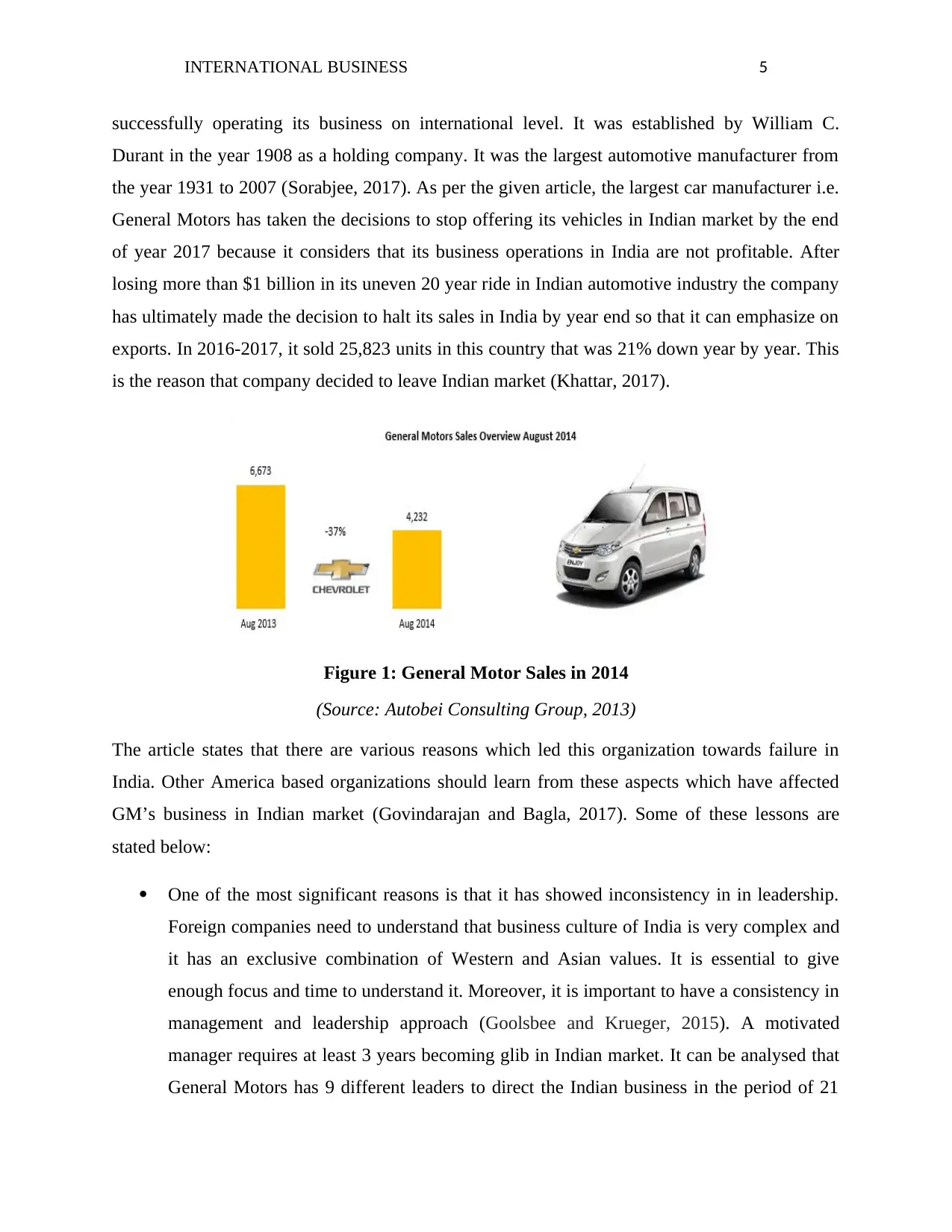
INTERNATIONAL BUSINESS 5
successfully operating its business on international level. It was established by William C.
Durant in the year 1908 as a holding company. It was the largest automotive manufacturer from
the year 1931 to 2007 (Sorabjee, 2017). As per the given article, the largest car manufacturer i.e.
General Motors has taken the decisions to stop offering its vehicles in Indian market by the end
of year 2017 because it considers that its business operations in India are not profitable. After
losing more than $1 billion in its uneven 20 year ride in Indian automotive industry the company
has ultimately made the decision to halt its sales in India by year end so that it can emphasize on
exports. In 2016-2017, it sold 25,823 units in this country that was 21% down year by year. This
is the reason that company decided to leave Indian market (Khattar, 2017).
Figure 1: General Motor Sales in 2014
(Source: Autobei Consulting Group, 2013)
The article states that there are various reasons which led this organization towards failure in
India. Other America based organizations should learn from these aspects which have affected
GM’s business in Indian market (Govindarajan and Bagla, 2017). Some of these lessons are
stated below:
One of the most significant reasons is that it has showed inconsistency in in leadership.
Foreign companies need to understand that business culture of India is very complex and
it has an exclusive combination of Western and Asian values. It is essential to give
enough focus and time to understand it. Moreover, it is important to have a consistency in
management and leadership approach (Goolsbee and Krueger, 2015). A motivated
manager requires at least 3 years becoming glib in Indian market. It can be analysed that
General Motors has 9 different leaders to direct the Indian business in the period of 21
successfully operating its business on international level. It was established by William C.
Durant in the year 1908 as a holding company. It was the largest automotive manufacturer from
the year 1931 to 2007 (Sorabjee, 2017). As per the given article, the largest car manufacturer i.e.
General Motors has taken the decisions to stop offering its vehicles in Indian market by the end
of year 2017 because it considers that its business operations in India are not profitable. After
losing more than $1 billion in its uneven 20 year ride in Indian automotive industry the company
has ultimately made the decision to halt its sales in India by year end so that it can emphasize on
exports. In 2016-2017, it sold 25,823 units in this country that was 21% down year by year. This
is the reason that company decided to leave Indian market (Khattar, 2017).
Figure 1: General Motor Sales in 2014
(Source: Autobei Consulting Group, 2013)
The article states that there are various reasons which led this organization towards failure in
India. Other America based organizations should learn from these aspects which have affected
GM’s business in Indian market (Govindarajan and Bagla, 2017). Some of these lessons are
stated below:
One of the most significant reasons is that it has showed inconsistency in in leadership.
Foreign companies need to understand that business culture of India is very complex and
it has an exclusive combination of Western and Asian values. It is essential to give
enough focus and time to understand it. Moreover, it is important to have a consistency in
management and leadership approach (Goolsbee and Krueger, 2015). A motivated
manager requires at least 3 years becoming glib in Indian market. It can be analysed that
General Motors has 9 different leaders to direct the Indian business in the period of 21
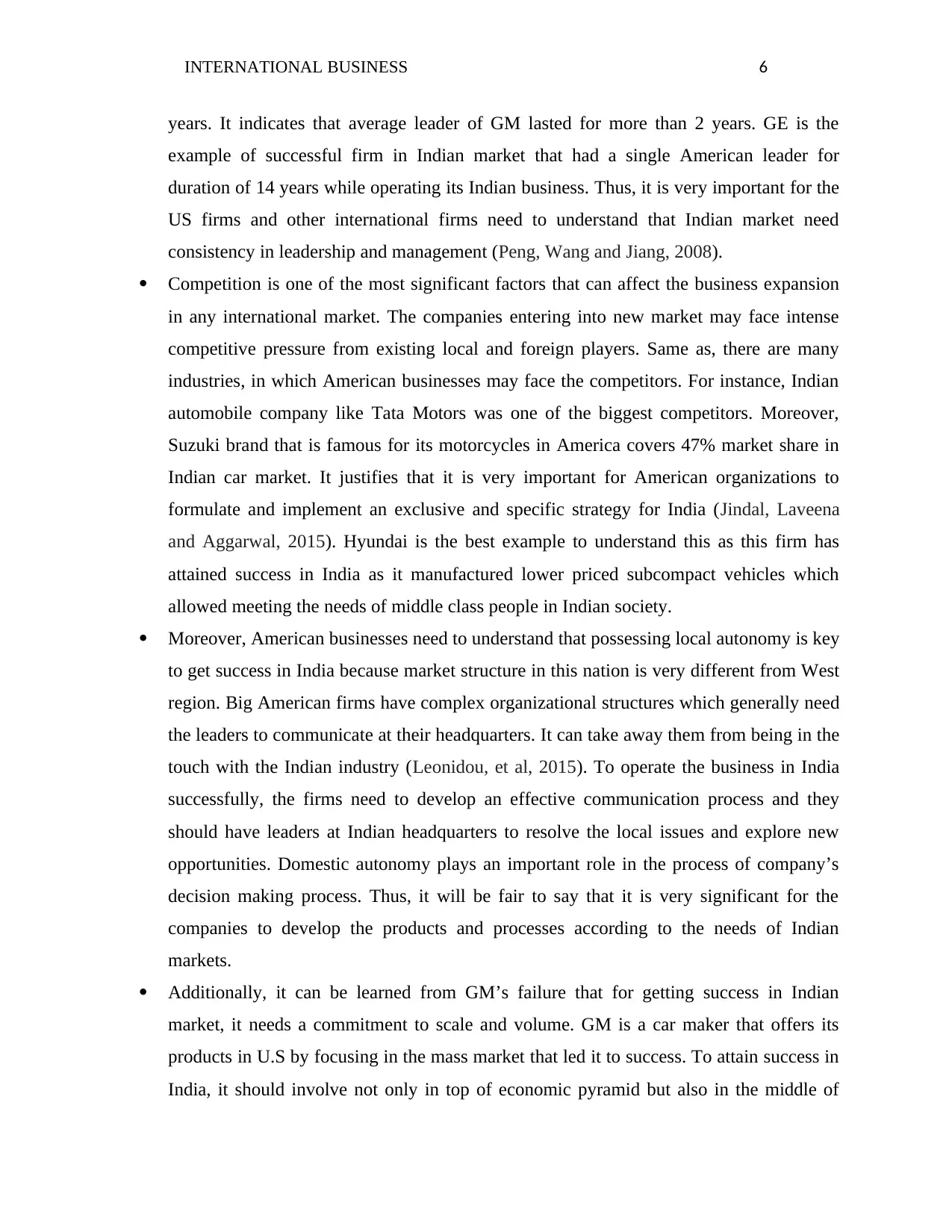
INTERNATIONAL BUSINESS 6
years. It indicates that average leader of GM lasted for more than 2 years. GE is the
example of successful firm in Indian market that had a single American leader for
duration of 14 years while operating its Indian business. Thus, it is very important for the
US firms and other international firms need to understand that Indian market need
consistency in leadership and management (Peng, Wang and Jiang, 2008).
Competition is one of the most significant factors that can affect the business expansion
in any international market. The companies entering into new market may face intense
competitive pressure from existing local and foreign players. Same as, there are many
industries, in which American businesses may face the competitors. For instance, Indian
automobile company like Tata Motors was one of the biggest competitors. Moreover,
Suzuki brand that is famous for its motorcycles in America covers 47% market share in
Indian car market. It justifies that it is very important for American organizations to
formulate and implement an exclusive and specific strategy for India (Jindal, Laveena
and Aggarwal, 2015). Hyundai is the best example to understand this as this firm has
attained success in India as it manufactured lower priced subcompact vehicles which
allowed meeting the needs of middle class people in Indian society.
Moreover, American businesses need to understand that possessing local autonomy is key
to get success in India because market structure in this nation is very different from West
region. Big American firms have complex organizational structures which generally need
the leaders to communicate at their headquarters. It can take away them from being in the
touch with the Indian industry (Leonidou, et al, 2015). To operate the business in India
successfully, the firms need to develop an effective communication process and they
should have leaders at Indian headquarters to resolve the local issues and explore new
opportunities. Domestic autonomy plays an important role in the process of company’s
decision making process. Thus, it will be fair to say that it is very significant for the
companies to develop the products and processes according to the needs of Indian
markets.
Additionally, it can be learned from GM’s failure that for getting success in Indian
market, it needs a commitment to scale and volume. GM is a car maker that offers its
products in U.S by focusing in the mass market that led it to success. To attain success in
India, it should involve not only in top of economic pyramid but also in the middle of
years. It indicates that average leader of GM lasted for more than 2 years. GE is the
example of successful firm in Indian market that had a single American leader for
duration of 14 years while operating its Indian business. Thus, it is very important for the
US firms and other international firms need to understand that Indian market need
consistency in leadership and management (Peng, Wang and Jiang, 2008).
Competition is one of the most significant factors that can affect the business expansion
in any international market. The companies entering into new market may face intense
competitive pressure from existing local and foreign players. Same as, there are many
industries, in which American businesses may face the competitors. For instance, Indian
automobile company like Tata Motors was one of the biggest competitors. Moreover,
Suzuki brand that is famous for its motorcycles in America covers 47% market share in
Indian car market. It justifies that it is very important for American organizations to
formulate and implement an exclusive and specific strategy for India (Jindal, Laveena
and Aggarwal, 2015). Hyundai is the best example to understand this as this firm has
attained success in India as it manufactured lower priced subcompact vehicles which
allowed meeting the needs of middle class people in Indian society.
Moreover, American businesses need to understand that possessing local autonomy is key
to get success in India because market structure in this nation is very different from West
region. Big American firms have complex organizational structures which generally need
the leaders to communicate at their headquarters. It can take away them from being in the
touch with the Indian industry (Leonidou, et al, 2015). To operate the business in India
successfully, the firms need to develop an effective communication process and they
should have leaders at Indian headquarters to resolve the local issues and explore new
opportunities. Domestic autonomy plays an important role in the process of company’s
decision making process. Thus, it will be fair to say that it is very significant for the
companies to develop the products and processes according to the needs of Indian
markets.
Additionally, it can be learned from GM’s failure that for getting success in Indian
market, it needs a commitment to scale and volume. GM is a car maker that offers its
products in U.S by focusing in the mass market that led it to success. To attain success in
India, it should involve not only in top of economic pyramid but also in the middle of
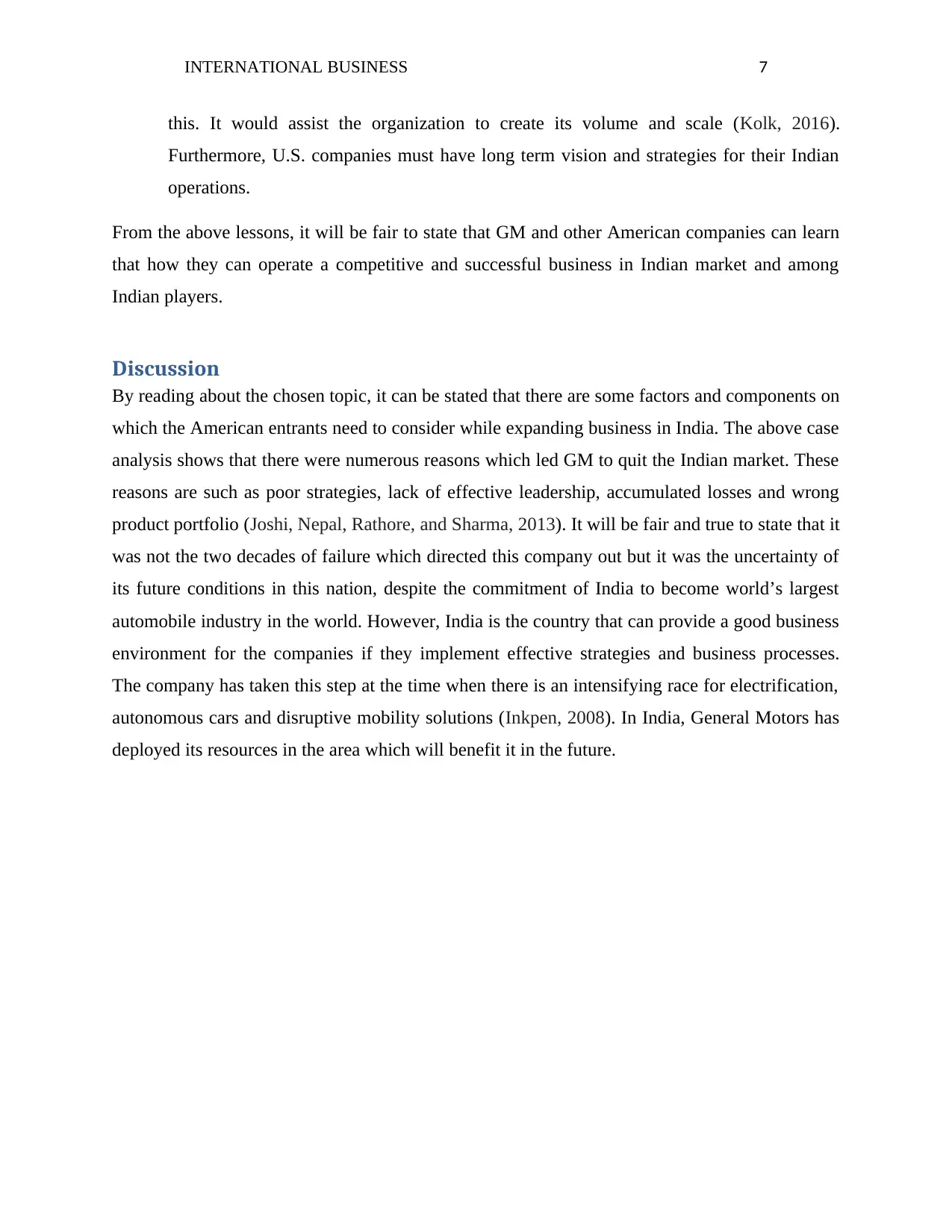
INTERNATIONAL BUSINESS 7
this. It would assist the organization to create its volume and scale (Kolk, 2016).
Furthermore, U.S. companies must have long term vision and strategies for their Indian
operations.
From the above lessons, it will be fair to state that GM and other American companies can learn
that how they can operate a competitive and successful business in Indian market and among
Indian players.
Discussion
By reading about the chosen topic, it can be stated that there are some factors and components on
which the American entrants need to consider while expanding business in India. The above case
analysis shows that there were numerous reasons which led GM to quit the Indian market. These
reasons are such as poor strategies, lack of effective leadership, accumulated losses and wrong
product portfolio (Joshi, Nepal, Rathore, and Sharma, 2013). It will be fair and true to state that it
was not the two decades of failure which directed this company out but it was the uncertainty of
its future conditions in this nation, despite the commitment of India to become world’s largest
automobile industry in the world. However, India is the country that can provide a good business
environment for the companies if they implement effective strategies and business processes.
The company has taken this step at the time when there is an intensifying race for electrification,
autonomous cars and disruptive mobility solutions (Inkpen, 2008). In India, General Motors has
deployed its resources in the area which will benefit it in the future.
this. It would assist the organization to create its volume and scale (Kolk, 2016).
Furthermore, U.S. companies must have long term vision and strategies for their Indian
operations.
From the above lessons, it will be fair to state that GM and other American companies can learn
that how they can operate a competitive and successful business in Indian market and among
Indian players.
Discussion
By reading about the chosen topic, it can be stated that there are some factors and components on
which the American entrants need to consider while expanding business in India. The above case
analysis shows that there were numerous reasons which led GM to quit the Indian market. These
reasons are such as poor strategies, lack of effective leadership, accumulated losses and wrong
product portfolio (Joshi, Nepal, Rathore, and Sharma, 2013). It will be fair and true to state that it
was not the two decades of failure which directed this company out but it was the uncertainty of
its future conditions in this nation, despite the commitment of India to become world’s largest
automobile industry in the world. However, India is the country that can provide a good business
environment for the companies if they implement effective strategies and business processes.
The company has taken this step at the time when there is an intensifying race for electrification,
autonomous cars and disruptive mobility solutions (Inkpen, 2008). In India, General Motors has
deployed its resources in the area which will benefit it in the future.
Paraphrase This Document
Need a fresh take? Get an instant paraphrase of this document with our AI Paraphraser
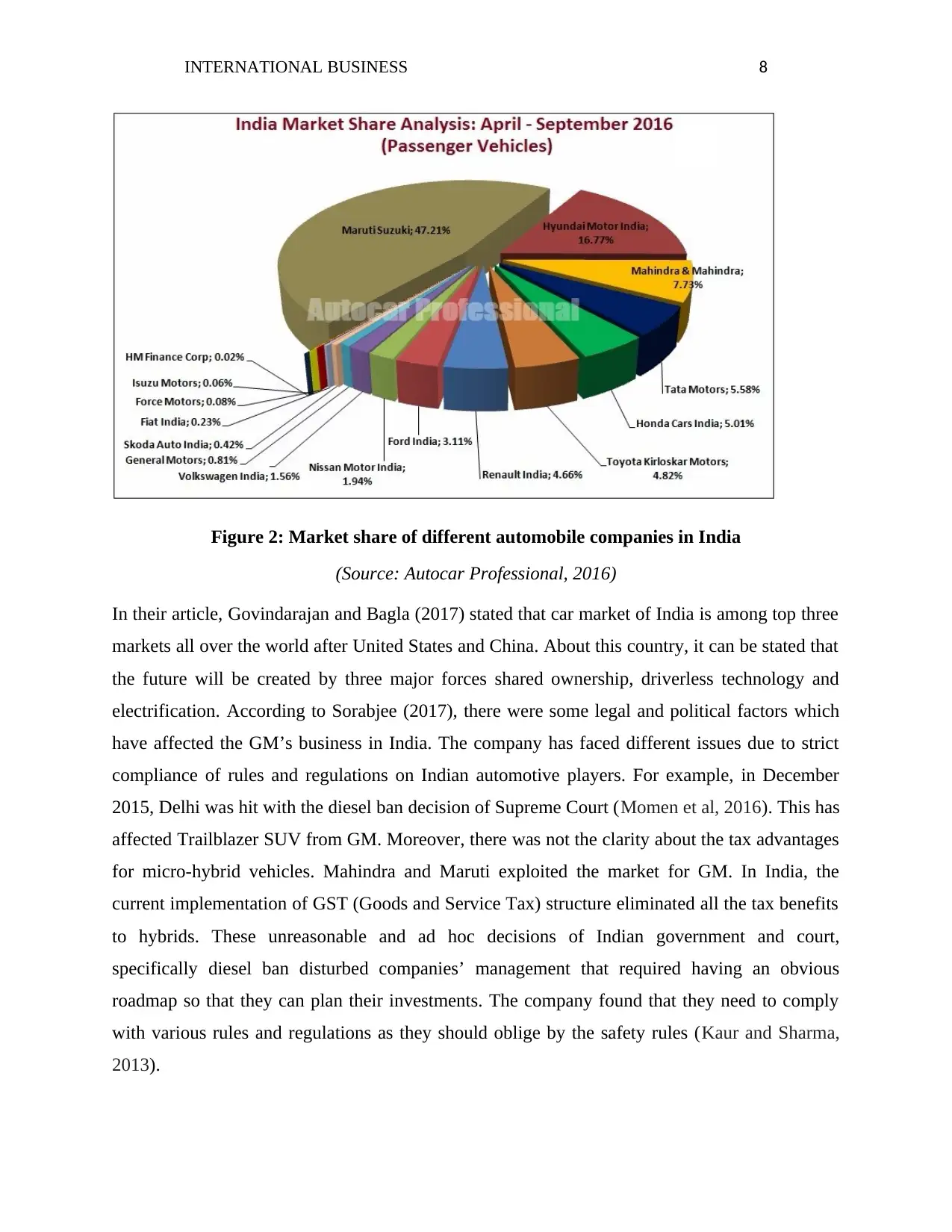
INTERNATIONAL BUSINESS 8
Figure 2: Market share of different automobile companies in India
(Source: Autocar Professional, 2016)
In their article, Govindarajan and Bagla (2017) stated that car market of India is among top three
markets all over the world after United States and China. About this country, it can be stated that
the future will be created by three major forces shared ownership, driverless technology and
electrification. According to Sorabjee (2017), there were some legal and political factors which
have affected the GM’s business in India. The company has faced different issues due to strict
compliance of rules and regulations on Indian automotive players. For example, in December
2015, Delhi was hit with the diesel ban decision of Supreme Court (Momen et al, 2016). This has
affected Trailblazer SUV from GM. Moreover, there was not the clarity about the tax advantages
for micro-hybrid vehicles. Mahindra and Maruti exploited the market for GM. In India, the
current implementation of GST (Goods and Service Tax) structure eliminated all the tax benefits
to hybrids. These unreasonable and ad hoc decisions of Indian government and court,
specifically diesel ban disturbed companies’ management that required having an obvious
roadmap so that they can plan their investments. The company found that they need to comply
with various rules and regulations as they should oblige by the safety rules (Kaur and Sharma,
2013).
Figure 2: Market share of different automobile companies in India
(Source: Autocar Professional, 2016)
In their article, Govindarajan and Bagla (2017) stated that car market of India is among top three
markets all over the world after United States and China. About this country, it can be stated that
the future will be created by three major forces shared ownership, driverless technology and
electrification. According to Sorabjee (2017), there were some legal and political factors which
have affected the GM’s business in India. The company has faced different issues due to strict
compliance of rules and regulations on Indian automotive players. For example, in December
2015, Delhi was hit with the diesel ban decision of Supreme Court (Momen et al, 2016). This has
affected Trailblazer SUV from GM. Moreover, there was not the clarity about the tax advantages
for micro-hybrid vehicles. Mahindra and Maruti exploited the market for GM. In India, the
current implementation of GST (Goods and Service Tax) structure eliminated all the tax benefits
to hybrids. These unreasonable and ad hoc decisions of Indian government and court,
specifically diesel ban disturbed companies’ management that required having an obvious
roadmap so that they can plan their investments. The company found that they need to comply
with various rules and regulations as they should oblige by the safety rules (Kaur and Sharma,
2013).
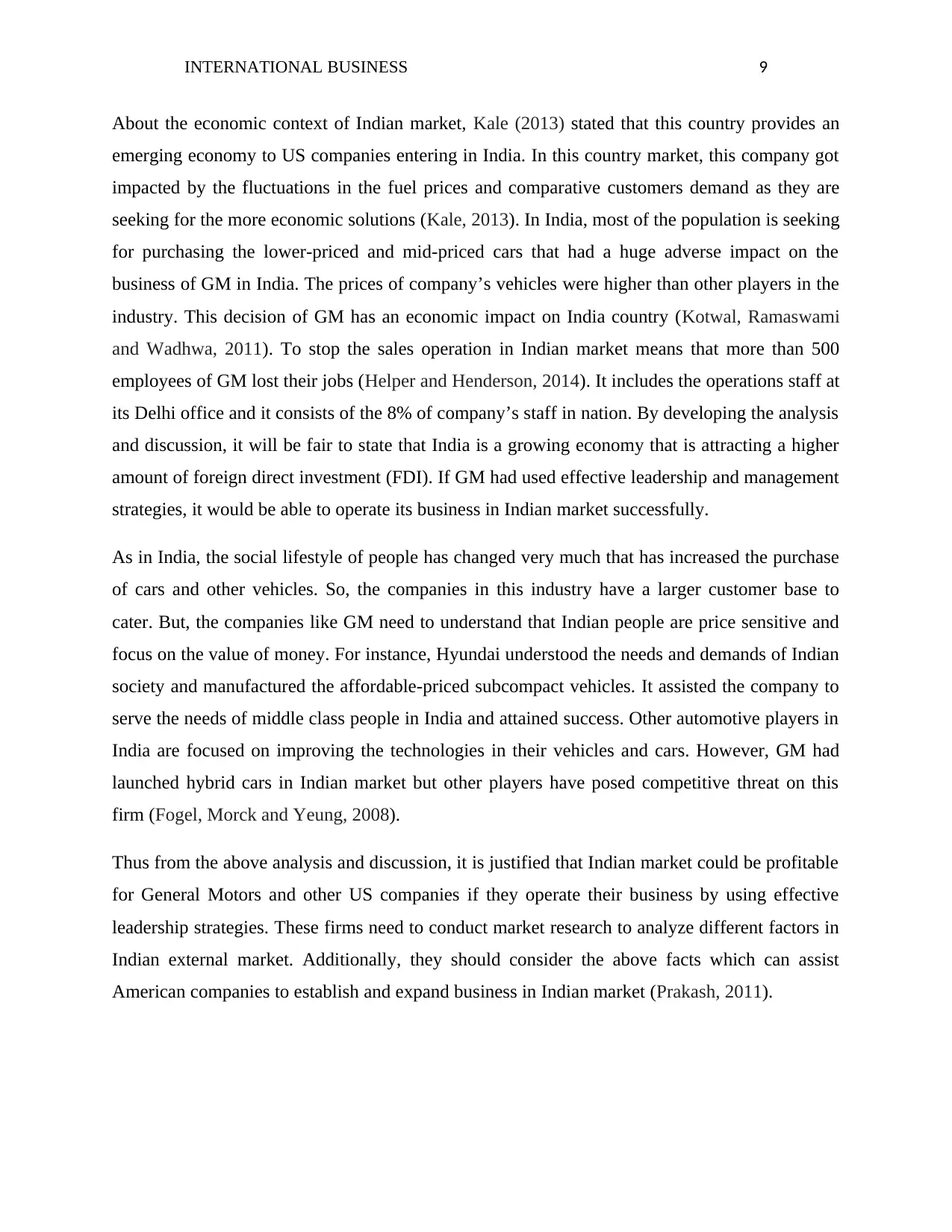
INTERNATIONAL BUSINESS 9
About the economic context of Indian market, Kale (2013) stated that this country provides an
emerging economy to US companies entering in India. In this country market, this company got
impacted by the fluctuations in the fuel prices and comparative customers demand as they are
seeking for the more economic solutions (Kale, 2013). In India, most of the population is seeking
for purchasing the lower-priced and mid-priced cars that had a huge adverse impact on the
business of GM in India. The prices of company’s vehicles were higher than other players in the
industry. This decision of GM has an economic impact on India country (Kotwal, Ramaswami
and Wadhwa, 2011). To stop the sales operation in Indian market means that more than 500
employees of GM lost their jobs (Helper and Henderson, 2014). It includes the operations staff at
its Delhi office and it consists of the 8% of company’s staff in nation. By developing the analysis
and discussion, it will be fair to state that India is a growing economy that is attracting a higher
amount of foreign direct investment (FDI). If GM had used effective leadership and management
strategies, it would be able to operate its business in Indian market successfully.
As in India, the social lifestyle of people has changed very much that has increased the purchase
of cars and other vehicles. So, the companies in this industry have a larger customer base to
cater. But, the companies like GM need to understand that Indian people are price sensitive and
focus on the value of money. For instance, Hyundai understood the needs and demands of Indian
society and manufactured the affordable-priced subcompact vehicles. It assisted the company to
serve the needs of middle class people in India and attained success. Other automotive players in
India are focused on improving the technologies in their vehicles and cars. However, GM had
launched hybrid cars in Indian market but other players have posed competitive threat on this
firm (Fogel, Morck and Yeung, 2008).
Thus from the above analysis and discussion, it is justified that Indian market could be profitable
for General Motors and other US companies if they operate their business by using effective
leadership strategies. These firms need to conduct market research to analyze different factors in
Indian external market. Additionally, they should consider the above facts which can assist
American companies to establish and expand business in Indian market (Prakash, 2011).
About the economic context of Indian market, Kale (2013) stated that this country provides an
emerging economy to US companies entering in India. In this country market, this company got
impacted by the fluctuations in the fuel prices and comparative customers demand as they are
seeking for the more economic solutions (Kale, 2013). In India, most of the population is seeking
for purchasing the lower-priced and mid-priced cars that had a huge adverse impact on the
business of GM in India. The prices of company’s vehicles were higher than other players in the
industry. This decision of GM has an economic impact on India country (Kotwal, Ramaswami
and Wadhwa, 2011). To stop the sales operation in Indian market means that more than 500
employees of GM lost their jobs (Helper and Henderson, 2014). It includes the operations staff at
its Delhi office and it consists of the 8% of company’s staff in nation. By developing the analysis
and discussion, it will be fair to state that India is a growing economy that is attracting a higher
amount of foreign direct investment (FDI). If GM had used effective leadership and management
strategies, it would be able to operate its business in Indian market successfully.
As in India, the social lifestyle of people has changed very much that has increased the purchase
of cars and other vehicles. So, the companies in this industry have a larger customer base to
cater. But, the companies like GM need to understand that Indian people are price sensitive and
focus on the value of money. For instance, Hyundai understood the needs and demands of Indian
society and manufactured the affordable-priced subcompact vehicles. It assisted the company to
serve the needs of middle class people in India and attained success. Other automotive players in
India are focused on improving the technologies in their vehicles and cars. However, GM had
launched hybrid cars in Indian market but other players have posed competitive threat on this
firm (Fogel, Morck and Yeung, 2008).
Thus from the above analysis and discussion, it is justified that Indian market could be profitable
for General Motors and other US companies if they operate their business by using effective
leadership strategies. These firms need to conduct market research to analyze different factors in
Indian external market. Additionally, they should consider the above facts which can assist
American companies to establish and expand business in Indian market (Prakash, 2011).
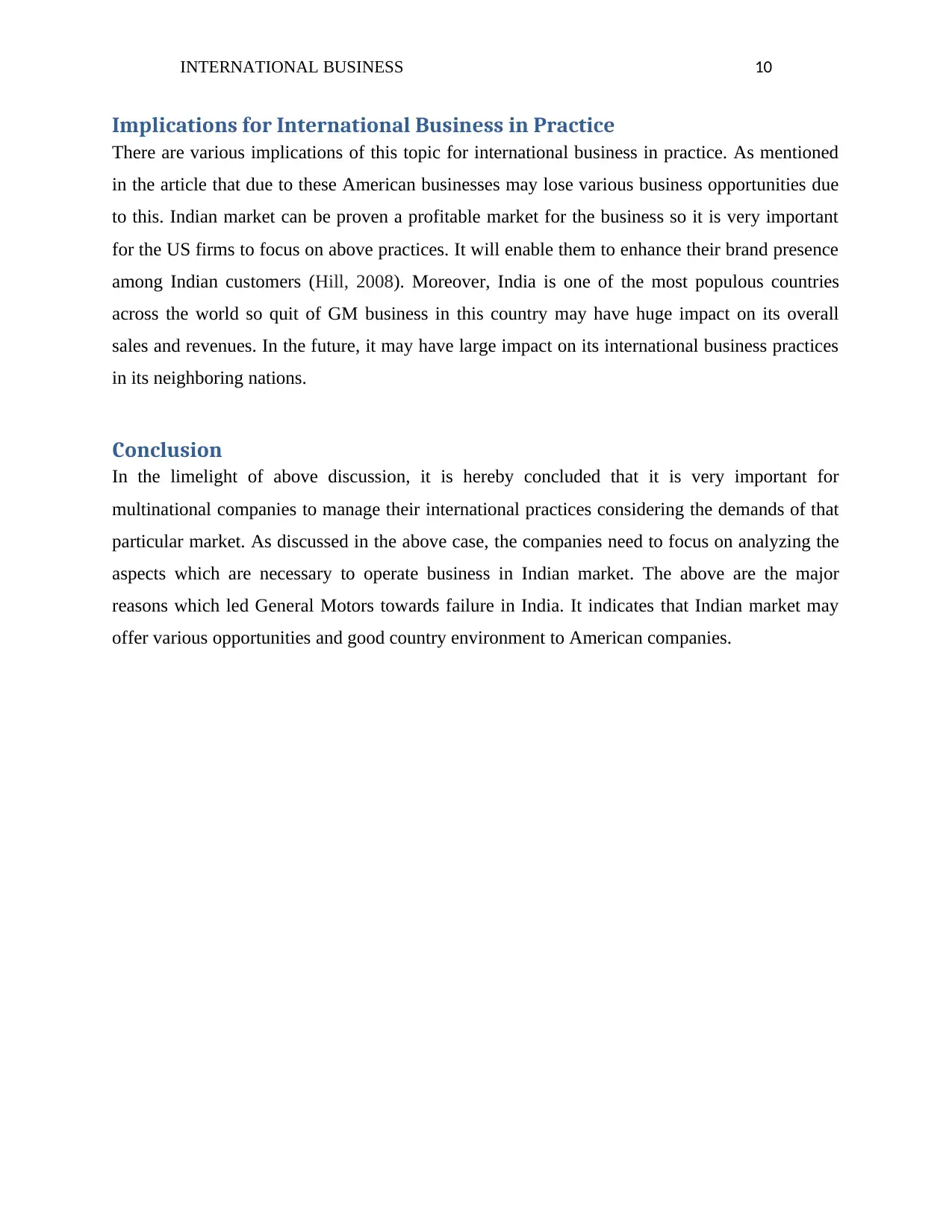
INTERNATIONAL BUSINESS 10
Implications for International Business in Practice
There are various implications of this topic for international business in practice. As mentioned
in the article that due to these American businesses may lose various business opportunities due
to this. Indian market can be proven a profitable market for the business so it is very important
for the US firms to focus on above practices. It will enable them to enhance their brand presence
among Indian customers (Hill, 2008). Moreover, India is one of the most populous countries
across the world so quit of GM business in this country may have huge impact on its overall
sales and revenues. In the future, it may have large impact on its international business practices
in its neighboring nations.
Conclusion
In the limelight of above discussion, it is hereby concluded that it is very important for
multinational companies to manage their international practices considering the demands of that
particular market. As discussed in the above case, the companies need to focus on analyzing the
aspects which are necessary to operate business in Indian market. The above are the major
reasons which led General Motors towards failure in India. It indicates that Indian market may
offer various opportunities and good country environment to American companies.
Implications for International Business in Practice
There are various implications of this topic for international business in practice. As mentioned
in the article that due to these American businesses may lose various business opportunities due
to this. Indian market can be proven a profitable market for the business so it is very important
for the US firms to focus on above practices. It will enable them to enhance their brand presence
among Indian customers (Hill, 2008). Moreover, India is one of the most populous countries
across the world so quit of GM business in this country may have huge impact on its overall
sales and revenues. In the future, it may have large impact on its international business practices
in its neighboring nations.
Conclusion
In the limelight of above discussion, it is hereby concluded that it is very important for
multinational companies to manage their international practices considering the demands of that
particular market. As discussed in the above case, the companies need to focus on analyzing the
aspects which are necessary to operate business in Indian market. The above are the major
reasons which led General Motors towards failure in India. It indicates that Indian market may
offer various opportunities and good country environment to American companies.
Secure Best Marks with AI Grader
Need help grading? Try our AI Grader for instant feedback on your assignments.

INTERNATIONAL BUSINESS 11
References
Fogel, K., Morck, R. and Yeung, B., 2008. Big business stability and economic growth: Is what's
good for General Motors good for America?. Journal of Financial Economics, 89(1), pp.83-108.
Goolsbee, A.D. and Krueger, A.B., 2015. A retrospective look at rescuing and restructuring
general motors and chrysler. Journal of Economic Perspectives, 29(2), pp.3-24.
Govindarajan, V. and Bagla, G., 2017, What U.S. CEOs Can Learn from GM’s India Failure,
Available from https://hbr.org/2017/06/what-u-s-ceos-can-learn-from-gms-india-failure
[Accessed on 24 October 2018].
Helper, S. and Henderson, R., 2014. Management practices, relational contracts, and the decline
of General Motors. Journal of Economic Perspectives, 28(1), pp.49-72.
Hill, C., 2008. International business: Competing in the global market place. Strategic
Direction, 24(9).
Inkpen, A.C., 2008. Knowledge transfer and international joint ventures: the case of NUMMI
and General Motors. Strategic Management Journal, 29(4), pp.447-453.
Jindal, S., Laveena, L. and Aggarwal, A., 2015. A comparitive study of crisis management-
Toyota v/s General motors. Scholedge International Journal of Management & Development
ISSN 2394-3378, 2(6), pp.1-12.
Joshi, D., Nepal, B., Rathore, A.P.S. and Sharma, D., 2013. On supply chain competitiveness of
Indian automotive component manufacturing industry. International Journal of Production
Economics, 143(1), pp.151-161.
Kale, D., 2017. Sources of innovation and technology capability development in the Indian
automobile industry. Institutions and Economies, 4(2), pp.121-150.
Kaur, A. and Sharma, P.C., 2017. Sustainability as a strategy incorporated in decision making at
supply chain management-case study of General Motors. International Journal of Sustainable
Strategic Management, 5(3), pp.183-200.
References
Fogel, K., Morck, R. and Yeung, B., 2008. Big business stability and economic growth: Is what's
good for General Motors good for America?. Journal of Financial Economics, 89(1), pp.83-108.
Goolsbee, A.D. and Krueger, A.B., 2015. A retrospective look at rescuing and restructuring
general motors and chrysler. Journal of Economic Perspectives, 29(2), pp.3-24.
Govindarajan, V. and Bagla, G., 2017, What U.S. CEOs Can Learn from GM’s India Failure,
Available from https://hbr.org/2017/06/what-u-s-ceos-can-learn-from-gms-india-failure
[Accessed on 24 October 2018].
Helper, S. and Henderson, R., 2014. Management practices, relational contracts, and the decline
of General Motors. Journal of Economic Perspectives, 28(1), pp.49-72.
Hill, C., 2008. International business: Competing in the global market place. Strategic
Direction, 24(9).
Inkpen, A.C., 2008. Knowledge transfer and international joint ventures: the case of NUMMI
and General Motors. Strategic Management Journal, 29(4), pp.447-453.
Jindal, S., Laveena, L. and Aggarwal, A., 2015. A comparitive study of crisis management-
Toyota v/s General motors. Scholedge International Journal of Management & Development
ISSN 2394-3378, 2(6), pp.1-12.
Joshi, D., Nepal, B., Rathore, A.P.S. and Sharma, D., 2013. On supply chain competitiveness of
Indian automotive component manufacturing industry. International Journal of Production
Economics, 143(1), pp.151-161.
Kale, D., 2017. Sources of innovation and technology capability development in the Indian
automobile industry. Institutions and Economies, 4(2), pp.121-150.
Kaur, A. and Sharma, P.C., 2017. Sustainability as a strategy incorporated in decision making at
supply chain management-case study of General Motors. International Journal of Sustainable
Strategic Management, 5(3), pp.183-200.
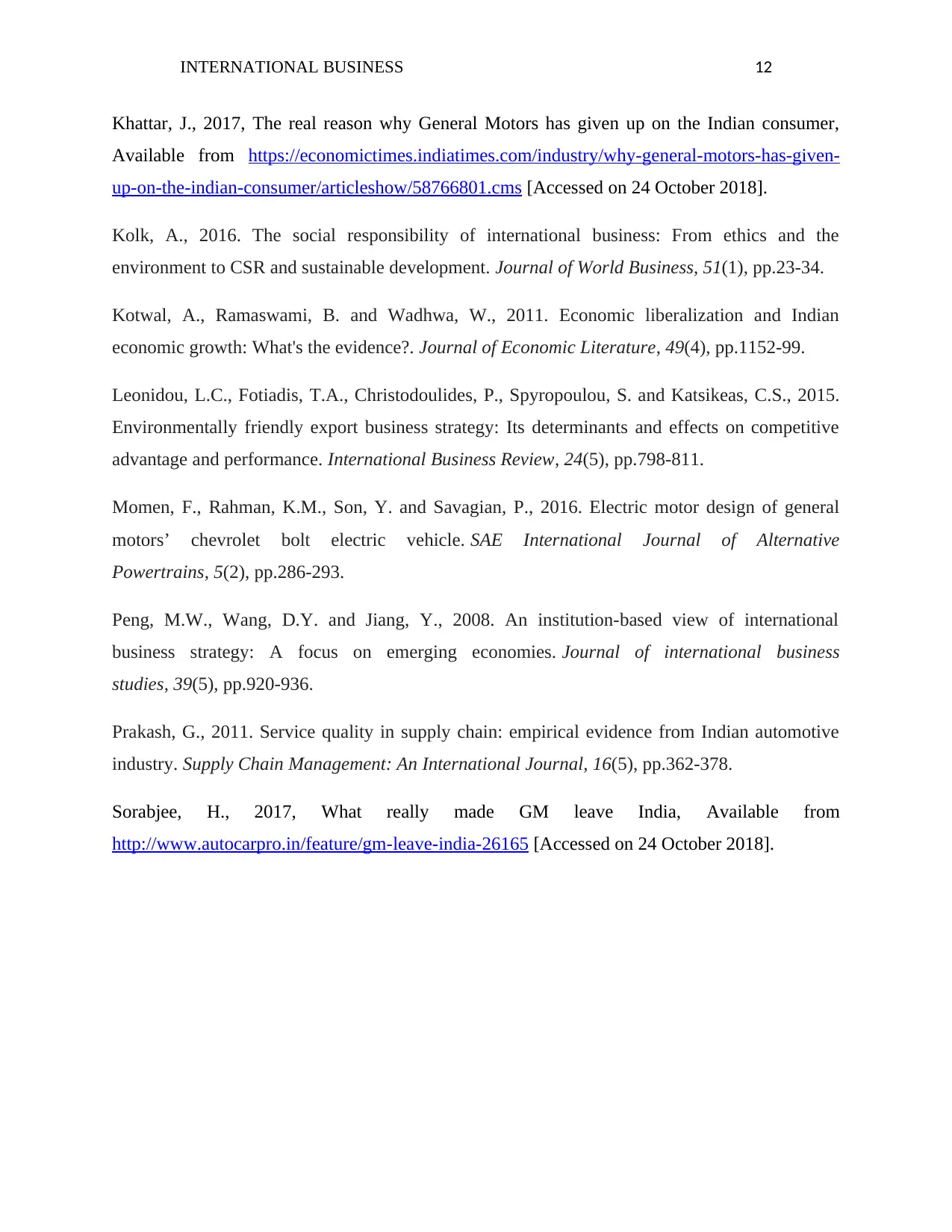
INTERNATIONAL BUSINESS 12
Khattar, J., 2017, The real reason why General Motors has given up on the Indian consumer,
Available from https://economictimes.indiatimes.com/industry/why-general-motors-has-given-
up-on-the-indian-consumer/articleshow/58766801.cms [Accessed on 24 October 2018].
Kolk, A., 2016. The social responsibility of international business: From ethics and the
environment to CSR and sustainable development. Journal of World Business, 51(1), pp.23-34.
Kotwal, A., Ramaswami, B. and Wadhwa, W., 2011. Economic liberalization and Indian
economic growth: What's the evidence?. Journal of Economic Literature, 49(4), pp.1152-99.
Leonidou, L.C., Fotiadis, T.A., Christodoulides, P., Spyropoulou, S. and Katsikeas, C.S., 2015.
Environmentally friendly export business strategy: Its determinants and effects on competitive
advantage and performance. International Business Review, 24(5), pp.798-811.
Momen, F., Rahman, K.M., Son, Y. and Savagian, P., 2016. Electric motor design of general
motors’ chevrolet bolt electric vehicle. SAE International Journal of Alternative
Powertrains, 5(2), pp.286-293.
Peng, M.W., Wang, D.Y. and Jiang, Y., 2008. An institution-based view of international
business strategy: A focus on emerging economies. Journal of international business
studies, 39(5), pp.920-936.
Prakash, G., 2011. Service quality in supply chain: empirical evidence from Indian automotive
industry. Supply Chain Management: An International Journal, 16(5), pp.362-378.
Sorabjee, H., 2017, What really made GM leave India, Available from
http://www.autocarpro.in/feature/gm-leave-india-26165 [Accessed on 24 October 2018].
Khattar, J., 2017, The real reason why General Motors has given up on the Indian consumer,
Available from https://economictimes.indiatimes.com/industry/why-general-motors-has-given-
up-on-the-indian-consumer/articleshow/58766801.cms [Accessed on 24 October 2018].
Kolk, A., 2016. The social responsibility of international business: From ethics and the
environment to CSR and sustainable development. Journal of World Business, 51(1), pp.23-34.
Kotwal, A., Ramaswami, B. and Wadhwa, W., 2011. Economic liberalization and Indian
economic growth: What's the evidence?. Journal of Economic Literature, 49(4), pp.1152-99.
Leonidou, L.C., Fotiadis, T.A., Christodoulides, P., Spyropoulou, S. and Katsikeas, C.S., 2015.
Environmentally friendly export business strategy: Its determinants and effects on competitive
advantage and performance. International Business Review, 24(5), pp.798-811.
Momen, F., Rahman, K.M., Son, Y. and Savagian, P., 2016. Electric motor design of general
motors’ chevrolet bolt electric vehicle. SAE International Journal of Alternative
Powertrains, 5(2), pp.286-293.
Peng, M.W., Wang, D.Y. and Jiang, Y., 2008. An institution-based view of international
business strategy: A focus on emerging economies. Journal of international business
studies, 39(5), pp.920-936.
Prakash, G., 2011. Service quality in supply chain: empirical evidence from Indian automotive
industry. Supply Chain Management: An International Journal, 16(5), pp.362-378.
Sorabjee, H., 2017, What really made GM leave India, Available from
http://www.autocarpro.in/feature/gm-leave-india-26165 [Accessed on 24 October 2018].

INTERNATIONAL BUSINESS 13
1 out of 13
Related Documents
Your All-in-One AI-Powered Toolkit for Academic Success.
+13062052269
info@desklib.com
Available 24*7 on WhatsApp / Email
![[object Object]](/_next/static/media/star-bottom.7253800d.svg)
Unlock your academic potential
© 2024 | Zucol Services PVT LTD | All rights reserved.





